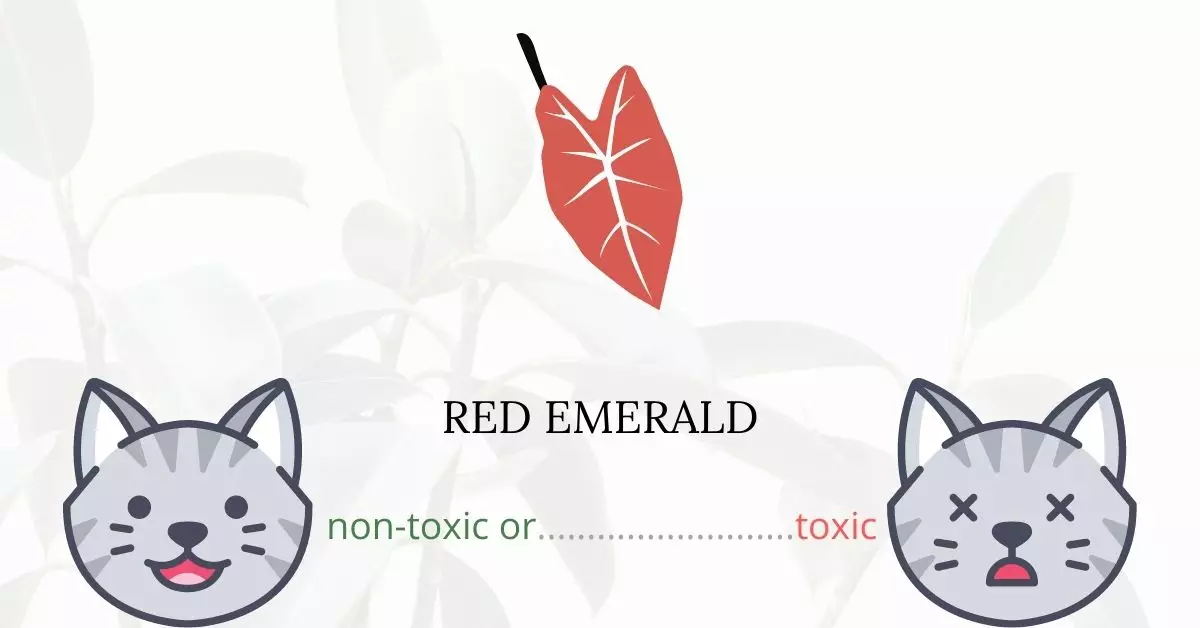The Red Emerald plant is indeed toxic to cats due to the presence of insoluble calcium oxalates, substances that, when contacted or ingested, can cause distress and discomfort in cats. When a cat chews on a Red Emerald, these insoluble calcium oxalate crystals are released, causing irritation to the lips, throat, and tongue, and inducing symptoms such as excessive pawing at the mouth, vomiting, or drooling due to the painful burning sensation. While the poisoning from this plant is typically not fatal, it can still bring about considerable suffering for your furry friend.
This article has been meticulously written in collaboration with a team of experienced Doctors of Veterinary Medicine (DVMs) who, through their invaluable insights and expertise, have contributed to the accuracy and reliability of the information provided on the potential risks associated with Red Emerald plants and their effects on cats. We have also substantiated our findings by referencing high-authority websites like ASPCA and PetMD to ensure the provision of the most up-to-date and reliable information. Our collective aim is to shed light on the implications of exposing cats to various plants, including the Red Emerald, and to guide pet owners in maintaining a safe environment for their pets.
Clinical Signs of Red Emerald Poisoning in Cats
Upon contact or ingestion of the Red Emerald plant, cats may present a range of clinical signs indicating potential poisoning. These symptoms arise due to the presence of insoluble calcium oxalates in the plant, which, when released, can cause a series of reactions in a cat’s body. Here’s a detailed explanation of each symptom and its cause:
- Inflammation of the oral cavity: The oxalate crystals present in the Red Emerald can act as mechanical irritants. When a cat chews or bites into the plant, these crystals are released and can embed themselves into the soft tissues of the cat’s mouth, leading to localized inflammation.
- Intense burning feeling in the mouth: The oxalate crystals from the Red Emerald, once released, interact with the mucous membranes in the cat’s mouth. This interaction results in a burning sensation, which is often immediately noticeable and distressing to the cat.
- Vomiting: If a cat ingests a significant portion of the plant, the irritation from the oxalate crystals isn’t limited to the mouth. As the plant material moves through the digestive tract, the stomach may react by trying to expel the irritant, leading to vomiting.
- Drooling: Excessive salivation or drooling is a direct response to the burning sensation and irritation in the mouth. As the cat’s body attempts to soothe the affected areas and possibly dilute or wash away the irritants, there is an increase in the production of saliva.
- Swallowing difficulties: Due to the inflammation and discomfort in the oral cavity, coupled with the embedded oxalate crystals, a cat may find it challenging to swallow. This difficulty can be observed as hesitation or repeated swallowing motions without the intake of food or water.
It’s essential to note that the severity of these symptoms may vary depending on the amount of the Red Emerald plant ingested or contacted. If a cat exhibits any of these signs after being in proximity to the plant, seeking immediate veterinary attention is crucial.
First Aid and Treatment of Red Emerald Poisoning in Cats
To eliminate any crystals that may be present, the doctor will carefully wash out your cat’s mouth. A gastric lavage, or stomach wash, may be performed by the vet to eliminate any poisons that may be present in the stomach cavity.
To assist decrease edema, the vet may need to prescribe Benadryl. If this is not given, your cat’s airways may swell shut, making it harder for him to breathe.
If your cat becomes dehydrated as a consequence of severe vomiting, the veterinarian can give him intravenous fluids to help him rehydrate and regain strength. Medications such as sucralfate and Kapectolin may also be used to coat the stomach lining and prevent additional discomfort to the cat.
Recovery from Red Emerald Poisoning in Cats
Most cats are discharged shortly after treatment, but others may need to stay longer if they are dehydrated and must be supervised by a veterinarian while they recover.
Once you are home, give your cat an ample supply of fluids. Let the cat rest in a quiet and cozy space at your home while recovering.
Prevention of Red Emerald Poisoning in Cats
Avoid growing red emerald philodendron in your gardens and even indoors. If your neighbor is growing this plant, you should limit your cat’s access outdoors. Keep him occupied and stimulated indoors to minimize the chance of straying away far from your house.
If you love plants but have cats at home, check out these lists:





